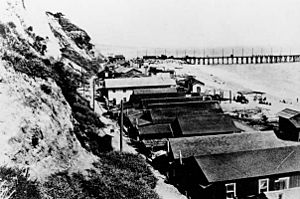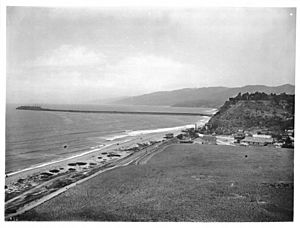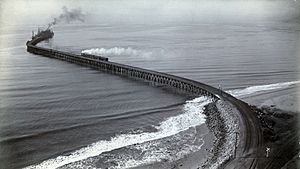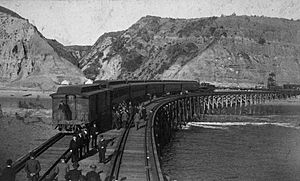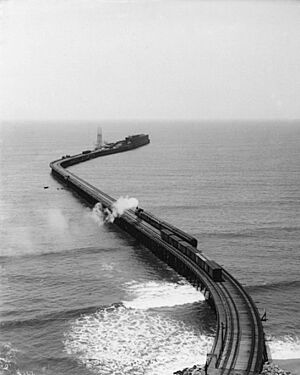Long Wharf (Santa Monica) facts for kids
Quick facts for kids Site of Port Los Angeles Long Wharf |
|
|---|---|
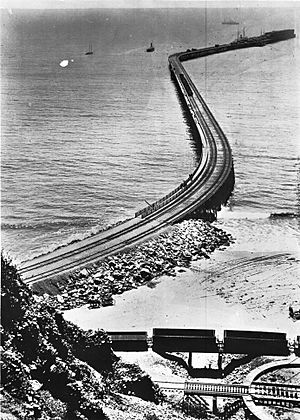
The Long Wharf in 1895
|
|
| Built | 1894 |
| Designated | May 9, 1975 |
| Reference no. | 881 |
The Long Wharf in Santa Monica, also known as Port Los Angeles or the Mile Long Pier, was a very long pier built by the Southern Pacific Railroad Company. It was constructed in Santa Monica Bay between 1892 and 1894.
When it opened in 1894, it was the longest pier in the world, stretching about 4,700 feet (nearly a mile!). It was used as a port where ships could load and unload goods and passengers. This continued until 1913.
Workers started taking the wharf apart in 1919. The very end of the pier, about 1,000 feet, was gone by 1920. The rest of the pier, which was still 3,600 feet long, became a fishing pier. It was finally removed completely in 1933.
One important item brought to the wharf was lumber. This wood came from northern ports and helped build many new homes and buildings in Southern California. Trains from the Southern Pacific Railroad and streetcars from the Los Angeles Pacific Railroad served the wharf. The Los Angeles Pacific Railroad carried passengers during the day and cargo at night.
Today, the site of the Port Los Angeles Long Wharf is a California Historical Landmark, number 881. The wharf was located north of the current Santa Monica Pier. You won't see any parts of the old pier there now. The area is now part of Pacific Palisades and California State Route 1, near the Will Rogers State Beach lifeguard station. A special plaque marks the spot, and you can see a few feet of old train track.
Contents
Building the Long Wharf
Los Angeles did not have a good natural harbor for ships. Because of this, the Southern Pacific Railroad and a man named Collis Potter Huntington wanted to build a major port in Santa Monica. Huntington worked with Nevada Senator John P. Jones, who founded Santa Monica. Together, they decided to build a mile-long pier into the Pacific Ocean. This pier was just north of Santa Monica Canyon.
Moving Goods by Rail
The pier had double track rail lines. These tracks helped move cargo and freight on and off the pier quickly. However, the pier stuck out far into the bay, which made it open to strong storms.
At the time, the Long Wharf took away some shipping business from San Pedro Bay. San Pedro Bay was very shallow back then, unlike the Long Wharf area. Senator Jones and Huntington used their political power. They tried to delay the building of a breakwater (a barrier to protect a harbor) in San Pedro Bay. They wanted a breakwater built in Santa Monica Bay instead.
The Free Harbor Fight
The publisher of the Los Angeles Times, Harrison Gray Otis, and U.S. Senator Stephen M. White pushed for federal money to build the Port of Los Angeles at San Pedro Bay. This disagreement was called the Free Harbor Fight.
The fight ended in 1897 when a special group, led by Rear Admiral John Grimes Walker, chose San Pedro. With the U.S. government's support, construction of the breakwater in San Pedro began in 1899. The Los Angeles Harbor Commission was created in 1907. San Pedro Bay's port area became part of Los Angeles in 1909.
After this, the Santa Monica wharf lost much of its ship traffic to San Pedro. Santa Monica almost became as important as the Port of Los Angeles in San Pedro. But a political struggle between the Los Angeles Chamber of Commerce and the Southern Pacific Railroad led to the end of the Santa Monica wharf.
Early Train Lines to the Port
The Los Angeles and Independence Railroad was very important for the wharf's early success. The steep cliffs along the coast in Santa Monica made it hard to build many train lines. This gave Southern Pacific's trains a special advantage. They had the only train access to the oceanfront land and the wharf.
The wharf was also served by the Los Angeles Pacific Railroad's streetcars. It was one of the stops on their famous Balloon Route. The streetcar line that went to the wharf was called the Santa Monica Canyon Line. It was built in 1891. This line was an extension of the Santa Monica Air Line. It ran from Ocean Avenue and Colorado Avenue, through a tunnel, and down to the beach. In July 1911, Pacific Electric bought the line. It closed on August 22, 1933.
Santa Monica Local Line
The Santa Monica Local Line was a smaller streetcar line. It served the wharf and connected to the Santa Monica Air Line in Santa Monica.


